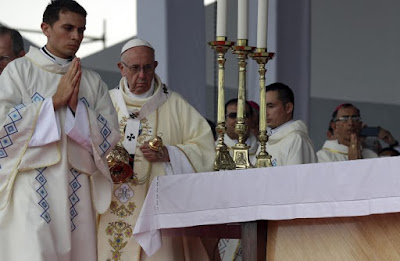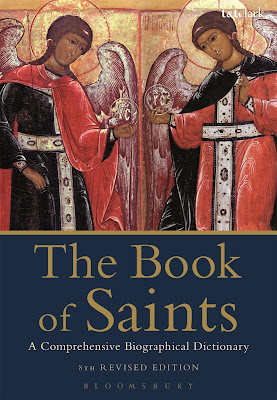Excerpted from "On Impurity" by St. Alphonsus Liguori. May we be inspired by these holy words to conquer all of these temptations, which much afflict us in this era. Lord have mercy!
The vice of impurity also brings with it obstinacy. To conquer temptations, particularly against chastity, continual prayer is necessary. ”Watch ye, and pray, that ye enter not into temptation.” (Mark xiv. 38.) But how will the unchaste, who are always seeking to be tempted, pray to God to deliver them from temptation? They sometimes, as St. Augustine confessed of himself, even abstain from prayer, through fear of being heard and cured of the disease, which they wish to continue. “I feared,” said the saint, “that you would soon hear and heal the disease of concupiscence, which I wished to be satiated, rather than extinguished.” (Conf., lib. 8, cap. vii.)Read the full account here
St. Peter calls this vice an unceasing sin. ”Having eyes full of adultery and sin that ceaseth not.” (2 Pet. ii. 14.) Impurity is called an unceasing sin on account of the obstinacy which it induces. Some person addicted to this vice says: I always confess the sin. So much the worse; for since you always relapse into sin, these confessions serve to make you persevere in the sin. The fear of punishment is diminished by saying: I always confess the sin. If you felt that this sin certainly merits hell, you would scarcely say: I will not give it up; I do not care if I am damned.
But the devil deceives you. Commit this sin, he says; for you afterwards confess it. But, to make a good confession of your sins, you must have true sorrow of the heart, and a firm purpose to sin no more. Where are this sorrow and this firm purpose of amendment, when you always return to the vomit? If you had had these dispositions, and had received sanctifying grace at your confessions, you should not have relapsed, or at least you should have abstained for a considerable time from relapsing.
You have always fallen back into sin in eight or ten days, and perhaps in a shorter time, after confession. What sign is this? It is a sign that you were always in enmity with God. If a sick man instantly vomits the medicine which he takes, it is a sign that his disease is incurable.
...
11. St. Remigius writes that, if children.be excepted, the number of adults that are saved is few, on account of the sins of the flesh. ”Exceptis parvulis ex adultis propter vitiam carnis pauci salvantur.” (Apud S. Cypr. de bono pudic.) In conformity with this doctrine, it was revealed to a holy soul, that as pride has filled hell with devils, so impurity fills it with men. (Col., disp. ix., ex. 192.) St. Isidore assigns the reason. He says that there is no vice which so much enslaves men to the devil as impurity. ”Magis per luxuriam, humanum genus subditur diabolo, quam per aliquod aliud.” (S. Isid., lib. 2, c. xxxix.) Hence, St. Augustine says, that with regard to this sin, ”the combat is common and the victory rare.” Hence it is, that on account of this sin hell is filled with souls.
12. All that I have said on this subject has been said, not that any one present, who has been addicted to the vice of impurity, may be driven to despair, but that such persons may be cured. Let us, then, come to the remedies. These are two great remedies prayer, and the flight of dangerous occasions. Prayer, says St. Gregory of Nyssa, is the safeguard of chastity. “Oratio pudicitiæ præsidium et tutamen est.” (De Orat.) And before him, Solomon, speaking of himself, said the same. “And as I knew that I could not otherwise be continent, except God gave it… I went to the Lord, and besought him.” (Wis. viii. 21.)
Thus, it is impossible for us to conquer this vice without God’s assistance. Hence, as soon as temptation against chastity presents itself, the remedy is, to turn instantly to God for help, and to repeat several times the most holy names of Jesus and Mary, which have a special virtue to banish bad thoughts of that kind. I have said immediately, without listening to, or beginning to argue with the temptation. When a bad thought occurs to the mind, it is necessary to shake it off instantly, as you would a spark that flies from the fire, and instantly to invoke aid from Jesus and Mary.
13. As to the flight of dangerous occasions, St. Philip Neri used to say that cowards that is, they who fly from the occasions gain the victory. Hence you must, in the first place, keep a restraint on the eyes, and must abstain from looking at young females. Otherwise, says St. Thomas, you can scarcely avoid the sin. ”Luxuria vitari vix protest nisi vitatur aspectus mulieris pulchræ.” (S. Thom. 1, 2, qu. 167, a. 2.) Hence Job said: ”I made a covenant with my eyes, that I would not so much as think upon a virgin” (xxxi. 1). He was afraid to look at a virgin; because from looks it is easy to pass to desires, and from desires to acts. St. Francis de Sales used to say, that to look at a woman does not do so much evil as to look at her a second time.
If the devil has not gained a victory the first, he will gain the second time. And if it be necessary to abstain from looking at females, it is much more necessary to avoid conversation with them. “Tarry not among women.” (Eccl. xlii. 12.) We should be persuaded that, in avoiding occasions of this sin, no caution can be too great. Hence we must be always fearful, and fly from them. ”A wise man feareth and declineth from evil; a fool is confident.” (Prov. xiv. 16.) A wise man is timid, and flies away; a fool is confident, and falls.



























